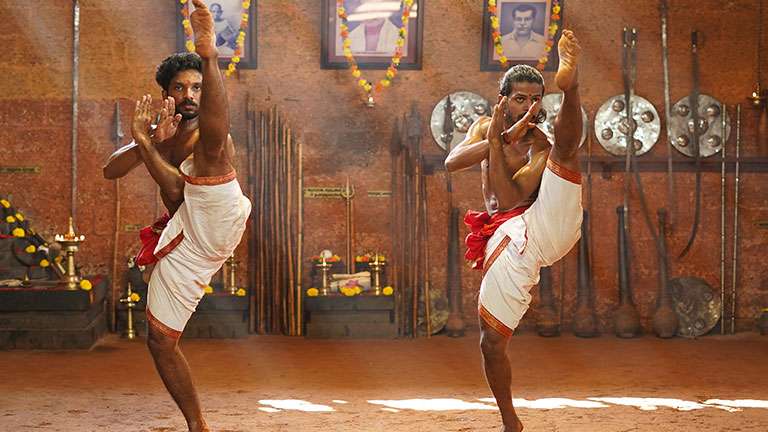
Kalaripayattu or Kalari (Kerala, India)
- Name of sport (game): Kalaripayattu
- Name in native language: കളരിപ്പയറ്റ് – from Malayalam - Kalari (school) payattu (fight)
- Place of practice (continent, state, nation):
Kerala state, South West coast of India.
- History:
Kalaripayattu is one of the oldest martial arts practiced to this day and its origins can be traced back to the ancient times. The very first mention of the Kerala martial art existence comes from the third century AD Tamil literature. However, it was not until the eleventh century that Kalaripayattu took the form we know today. It comes from the Malabar coast of the Ćera kingdom on which the Brahmins, or Hindu monks, have been practicing the martial arts in shrines called salad and ghatika since ancient times.
Kalaripayattu owes its existence to the war that broke out between the kingdom of Ćera and the kingdom of Ćola. This conflict lasted (with intervals) a hundred years and claimed hundreds of victims. At that time, many people were called to the army and brahmins were often responsible for their training. It was during the decades of trainings when Kalaripayattu eventually developed, and yet, the state of Ćera got defeated losing its lands to many feudal lords.
After the war it were the brahmins who contributed greatly to the survival of Kalaripayattu; they kept chronicles and trained new adepts. Some brahmins have been associated with this martial art for centuries - for example, the commander of the Calikut forces during the war with Portugal in 1509. This is where the connection between this martial art and Hinduism comes from. However, many of them abandoned monastic lifestyle and are described in medieval writings as cutthroats with bloodstained swords. Another factor that influenced the popularity of Kalaripayattu was instability in the region. Small feudal states led constant battles with each other, which led to the necessity of knowing the fighting techniques by the lower castes. In some parts of Kerala, compulsory education was in force and children from the age of 7 had to learn martial arts.
The golden age of Kalaripayattu ended in the eighteenth century with the arrival of the British. They brought firearm, the use of which meant that knowledge of martial arts was no longer necessary. Furthermore, Europeans banned the practice of Kalaripayattu what as a result, almost eradicated the martial art and its traditions.
Since India regained its independence in 1947, Kalaripayattu is experiencing a renaissance, not only in Kerala, but throughout the entire subcontinent. Numerous Bollywood films contain references and threads about this martial art. In 1995, the Indian Federation of Kalaripayattu was established. - Description:
Kalaripayattu is practiced in a special building called kalari. In the past there were several types of kalari. To this day, only two of them have remained popular – ceru (used for traditional medicine purposes) and kuzhi (training place).
Traditional kalari were built around a rectangular pit with dimensions of 12 x 6.5 meters. The bottom was encircled by clay walls and these on the other hand were strengthened with wooden beams. The 9 meters building was topped with a gable roof made of coconut leaves. This specific construction helped keeping the temperature as low as possible in very hot Keral climate. It was thanks to the light roof which made it possible for the cool wind to get inside at the same time blocking sunlight. What is more the high ceiling facilitating the circulation of air and the way kalari was build into the ground helped keeping the inside temperature low.
It is worth mentioning that even in Kerala, many masters transfer their kalari from traditional huts to modern buildings. One of the reasons is, paradoxically, the costs - the roof of coconut leaves must be renewed each year, and the professionals are very few.
Training
Before going down to the kalari, you should take off your shoes. At the entrance, a ritual follows. The student enters the kalari with his right foot, kneels and successively with his right hand touches the earth, then the head, and the heart. It has a symbolic meaning - what you learn in a building is understood by the brain and then - by the heart.
When we are in the kalari, the training begins. It is divided into three parts. The first one is preparation - the participants dress in langutti, it is loincloth covering the genitals and buttocks. This skimpy outfit is associated with the Indian climate, in which practicing sports in many layers of clothing is impractical. Next, the participants apply oil on the whole body. Oil helps the body to cool down when it is heated up due to ardent practise or protect the body from cold during the monsoon season but what is most important, oil increases flexibility of the body. Then comes the time for religious rituals. Hindus pray for their gods while Muslims look towards Mecca. After that, there are rituals of thanksgiving addressed to the gods, to the weapons, to the teacher, and many others. Finally, the exercises begin.
Warm up and repetition of the fight forms and kicks (more on that later) are followed by four sections of fighting - unarmed, fighting with sticks, fighting with white weapons and unarmed fights with special emphasis on marmas (by Tamil Medicine key points of the body used in Kalaripayattu during massage and fighting). When the first section ends, less advanced students have to leave the kalari. This elimination process is repeated after subsequent sections. Weaker and less advanced students can not look at the next stages of fighting so that they do not get bad habits out of them.
The section that exercises unarmed combat begins with mudras. These are Hindu and Buddhist symbolic gestures that strengthen the body (also used in yoga). Then, adavu exercises are performed (shifting from one fighting position to another, push-ups, squats and jumps). Mudras are repeated 6 times and adavu 18.
All the excercises are followed by armed training. In that section students practice using sticks, white weapons and emphasis on marmas. Both white weapons and ordinary sticks are highly respected. Grabbing a weapon, the warrior must apply it to his head, and then to the heart - a gesture analogous to that which he performs while entering to the kalari.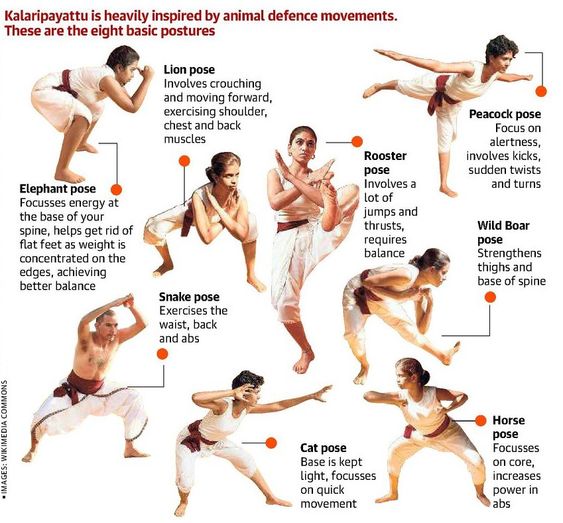
Some of the techniques:
• Six basic kicks:
-Nerkal – the kick is delivered above the head, with a straight knee and the toes extended.
-Vitukal – circling kick, from outside to inside; the stretched leg is circled in front of the body, with the foot reaching above the head.
-Akamkal – circling kick, from inside to outside; the stretched leg is circled in front of the body, with the foot reaching above the head.
-Konkal – similar to nerkal, but the right kick now goes towards the left shoulder, and left leg to the right shoulder.
-Tiriccukal – three straight kicks thrown by the same leg, while pivoting two Times 180 degrees on the other leg.
-Iruttikal – after having thrown a straight kick, the kicking leg sweeps back a bit behind the body. At that moment the practitioner shifts body weight to the hind leg, and squats down on that leg, while the inactive leg is kept forward.
• Vadivu, or the body positions during the fight (together with the cuvadu, that is feet positions during the fight form adavu):
-Gaja vadivu – pose of the elephant – feet parallel at shoulder width while crouching in a way that the knees are bent at 90 degrees.
-Simha vadivu – pose of the lion– similar to the position of the elephant but feet are put perpendicular and a bit than shoulder width apart.
-Asha vadivu – horse stance – one leg straight put behind, the other with the knee bent at 90 degrees put in front
-Kukkuda vadivu – stance of the cock – right leg raised with the big toe pointing up.
-Sarpa vadivu – stance of the serpent – similar to the position of the horse but upper body is more upright. In that way it is easier to turn 180 degrees.
-Marjava vadivu – pose of the cat – a crouching pose.Weapons:
-Kettukari – long stick – should be slightly longer than the user's height.
-Ceruvadi – short stick
-The Otta – curved stick
-Kathi – a traditional Keralian dagger with a handle made of deer antlers
-Vettukathi – Tamil machete
-Valum and Curika – swords
-Valum Parichayum – sword and shield, the most traditional weapon, symbol of Kalaripayattu
-Kuntham – Spear
-Maru – axe
-Urumi – a flexible sword - used in many Indian martial arts; also the last weapon to learn becouse an inexperienced user could have cut his head off. Its users wrap the sword around the waist.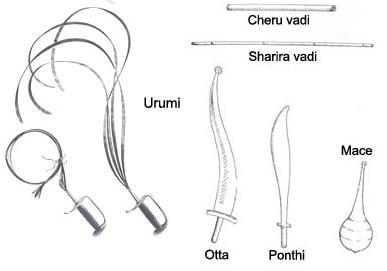
- Current status:
Kalaripayattu is still practised. Most schools can be found in Kerala, the birthplace of this sport (Calikut, Ernakulam, Wayanad). In addition, we can find sport centers in many large Indian cities (Delhi, Bangalore, Cennai). The Indian Kalaripayattu Federation has been operating since 1995 but this sport also gains in popularity in the west (Great Britain, Germany, France, etc.). In Poland, we find one such a center in Wroclaw.
- Importance (for practitioners, communities etc.):
Kalaripayattu has been influencing the culture of southern India for centuries. Another thing worth paying attention to is the Keral theater form called katakali. It binds traditional Indian theatrical motifs (dance, song, music) and elements of choreography borrowed from Kalaripayattu.
- Contacts:
Indian Kalaripayattu Federation:
Bhodhi Dharma Institute of Martial Arts, Poonthura P.O,
Thiruvananthapuram, Kerala, PIN-695026
Mob: 9447866944
Email:This email address is being protected from spambots. You need JavaScript enabled to view it.
Webside: https://www.indiankalaripayattufederation.com/
Parashurama Vallabhatta Kalari Academy: http://www.kalaripayattubangalore.com/
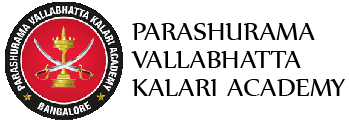
Alleppey Kalaripayattu: https://www.facebook.com/Ekaveerakalari/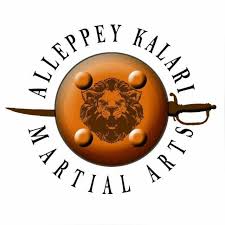
Australian School of Kalaripayattu: https://www.kalaripayattu.com.au/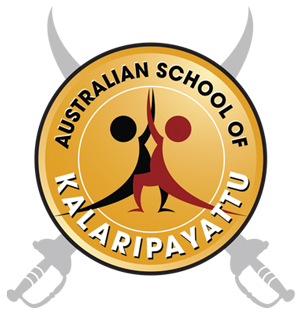
Calicut Kalaripayattu school: http://www.hindustankalari.com/
Ernakulam Kalaripayattu school: http://www.enskalari.org.in/
Wayanad Kalaripayattu school: http://kadathanadankalari.in/
Delhi Kalaripayattu school: http://kalarikendramdelhi.com/
Bangalore Kalaripayattu school: http://www.kalaripayattubangalore.com/
British Kalaripayattu school: http://www.kalarippayat.co.uk/home
French Kalaripayattu school: http://www.kalarippayat.asso.fr/
German Kalaripayattu school: http://kalari-center.de/ - Sources of information :
Books and articles:
Patrick Denaud, Kalaripayat: The Martial Arts Tradition of India, Destiny Books, 2009
Chirakkal T. Sreedharan Nair, Kalarippayattu: The Complete Guide to Kerala's Ancient, Westland Books Pvt Ltd, 2015
Phillip B. Zarrilli, When the Body Becomes All Eyes: Paradigms, Discourses and Practices of Power in Kalarippayattu, a South Indian Martial Art., Oxford University Press, 2001
Dick Luijendijk, Kalarippayat, 2008 - https://books.google.pl/books?id=hISikpYZ9hYC&pg=PA87&lpg=PA87&dq=kalari+building&source=bl&ots=Vlhz31XytS&sig=ACfU3U0V-0Q3il2qiSnv70lZo5U9ju6Mkg&hl=pl&sa=X&ved=2ahUKEwjvkc7ivobhAhVkonEKHcs7AXMQ6AEwBnoECAgQAQ#v=onepage&q=kalari%20building&f=false
P. Balakrishnan, KALARIPPAYATTU: History and methods of practicing the martial art of Kerala, Poorna Publications, 2003
Ranjan Mullaratt, Kalari Margam - Ancient secrets for modern living, 2014
John Shaji, Kalaripayattu, The martial and healing art of Kerala - https://www.academia.edu/29708005/KALARIPPAYATTU_The_Martial_and_healing_art_of_Kerala
https://martialkingdomindia.blogspot.com/2019/06/kalaripayattu.html?fbclid=IwAR14GMt5O4fL0nWhdsL45-44xMY2SkapA6-l_fub_RI93uODdgZffTYtkfE
https://indosphere.medium.com/the-wild-boar-pose-image-source-kalari-lab-koh-phangan-9aea07a00d9bVideo:
http://www.indiatraveltimes.com/kalarippayatu/kalari-circumstances.php
https://en.wikipedia.org/wiki/History_of_Kerala#Second_Cheras
http://www.indiatraveltimes.com/kerala/kalari.php
http://www.enskalari.org.in/history-of-kalari/
https://en.wikipedia.org/wiki/List_of_Kalarippayattu_films
https://www.indiankalaripayattufederation.com/kalaripayattu.php
https://books.google.pl/books?id=hISikpYZ9hYC&pg=PA87&lpg=PA87&dq=kalari+building&source=bl&ots=Vlhz31XytS&sig=ACfU3U0V-0Q3il2qiSnv70lZo5U9ju6Mkg&hl=pl&sa=X&ved=2ahUKEwjvkc7ivobhAhVkonEKHcs7AXMQ6AEwBnoECAgQAQ#v=onepage&q=kalari%20building&f=false
https://www.kalari.in/kalaripayattu/levels-weapons/
https://en.wikipedia.org/wiki/Malappuram_Kathi
https://www.quora.com/What-is-called-Vettukathi-or-Vettothi
https://www.quora.com/Which-are-the-best-Kalaripayattu-schools-in-India
An example kettukari fight - https://www.youtube.com/watch?v=4em3udgHIzs
https://www.youtube.com/watch?v=oI84oM_bJeg
https://www.youtube.com/watch?v=FUUNgyH_47Y
https://www.youtube.com/watch?v=YXmpNFIgqwU
https://www.youtube.com/watch?v=NUgJNebKmXASource of photos in this article:
https://karmagroup.com/blog/kalaripayattu-original-martial-art/
https://neuronerdz.com/about-kalarippayattu-the-worlds-first-martial-art/
https://www.thestatesman.com/features/vidyut-jammwal-popularise-kalaripayattu-indian-martial-art-1502925234.html
https://pl.pinterest.com/hashimhmk301/kalari/
https://televisionofnomads.com/kalaripayattu-kerala-indian-martial-arts/
https://adventurerivercruises.com/kerala/experiences/cultures/kalaripayattu-a-traditional-martial-arts-performance/
https://pl.pinterest.com/pin/134615476332160705/
https://chinesemartialstudies.com/2017/05/25/an-opportunity-to-document-the-indian-martial-arts/kalaripayattu/
https://www.keralatourism.org/kalaripayattu/origin
https://www.piggyride.com/course/kolthari-kalaripayattu-classes
https://www.keralatourism.org/kalaripayattu/angathari/urumi
https://www.thehindu.com/society/kalarigram-where-kalaripayattu-reigns-supreme/article24348791.ece
http://www.travelviewpoint.com/kalaripayattu-the-oldest-martial-art/
https://indosphere.medium.com/the-wild-boar-pose-image-source-kalari-lab-koh-phangan-9aea07a00d9b - Gallery:
- Documents:
 Effect_of_Kalaripayattu_on_physical_fitness_variables.pdf
Effect_of_Kalaripayattu_on_physical_fitness_variables.pdf

